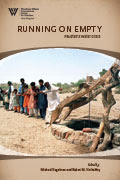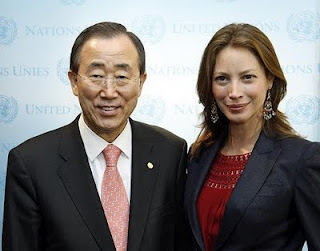-
Weekly Reading
›Climate change is “the biggest global health threat of the 21st century,” says the final report of a year-long commission held by The Lancet and University College London. A Lancet editorial, “Sexual and reproductive health and climate change,” says that rapid population growth “increases the scale of vulnerability to the consequences of climate change” and that meeting the unmet need for contraception “could slow high rates of population growth, thereby reducing demographic pressure on the environment.”
Following the escalation of hostilities in Gaza, the UN Environment Programme’s environmental assessment found that Gaza’s underground water supplies are “in danger of collapse as a result of years of over-use and contamination that have been exacerbated by the recent conflict.” IRIN reports that climate change has led to lower rainfall and “slowed the recharge rate of the aquifer” under Gaza, while “rapid population growth and suburban sprawl” have left “little space for rainwater catchment.”
In “Arctic Climate Feedbacks: Global Implications,” the World Wildlife Fund says that “warming in the Arctic will likely have far-reaching impacts throughout the world, resulting in a sharp increase in harmful greenhouse gases and significant shifts in global weather patterns that could disrupt the lives and livelihoods of hundreds of millions of people.”
The Obama Administration’s Interagency Ocean Policy Task Force Interim Report—now open for a 30-day review and comment period—“proposes a new National Policy that recognizes that America’s stewardship of the ocean, our coasts, and the Great Lakes is intrinsically and intimately linked to environmental sustainability, human health and well-being, national prosperity, adaptation to climate and other environmental change, social justice, foreign policy, and national and homeland security.”
The Economics of Climate Adaptation Working Group estimates that climate risks “could cost nations up to 19 percent of their GDP by 2030, with developing countries most vulnerable,” and warns that the “historic pace of population and GDP growth could put ever more people and value at risk.” However, the group also contends that “between 40 and 68 percent of the loss expected to 2030 in the case locations – under severe climate change scenarios – could be averted through adaptation measures whose economic benefits outweigh their costs.” -
When Talking Copenhagen, Think Pinch, Not Scoop
›September 21, 2009 // By Geoffrey D. Dabelko
For everyone preparing to converge on Denmark’s capital for the next round of climate change negotiations, I offer a helpful hint that you won’t find in any IPCC assessment.
It’s CopenHAYgun, not CopenHAAgen. (Watch the video for a demonstration.)
As we have seen with Kyoto and the 1997 negotiations, the Danish capital will become shorthand for success, failure, or futility. So whether you say it with a hopeful lilt or a cynical slur, at least pronounce it correctly.
Don’t think Häagen-Dazs. The Danes are quick to remind you that CopenHAAgen is the German pronunciation.
Growing up in southeastern Ohio actually prepared me well for this challenge. Plenty of fellas in my high school liked just a pinch of CopenHAYgun brand chewing tobacco between their cheek and gum.
So while it might be more appealing to dip into a quart of ice cream on the rocky road to December’s negotiations, instead think of dippin’ from a can of snuff. It’ll help you win the good graces of the hosts and also keep you awake during any snooze-inducing panels. -
Running on Empty: Pakistan’s Water Crisis
› “Water shortages,” warns South Asia scholar Anatol Lieven, “present the greatest future threat to the viability of Pakistan as a state and a society.
“Water shortages,” warns South Asia scholar Anatol Lieven, “present the greatest future threat to the viability of Pakistan as a state and a society.
This warning may be overstated, but Pakistan’s water situation is deeply troubling, as described in a new report from the Woodrow Wilson Center’s Asia Program, Running on Empty: Pakistan’s Water Crisis.
Water availability has plummeted from about 5,000 m3 per capita in the early 1950s to less than 1,500 m3 per capita today. As Simi Kamal reports in the first chapter of Running on Empty, Pakistan is expected to become “water-scarce” (below 1,000 m3 per capita) by 2035—though some experts project this could happen in 2020, if not earlier.
In an unstable nation like Pakistan, water shortages can easily become security threats. In April 2009, alarm bells sounded when the Taliban pushed southeast of Swat into the Buner district of the Northwest Frontier Province. Not only is Buner close to Islamabad, it lies just 60 kilometers from the prized Tarbela Dam, which provides Pakistan with billions of cubic meters of precious water for irrigation each year.
Soaked, Salty, Dirty, and Dry
According to Kamal, Pakistan faces significant and widespread water challenges:- Inefficient irrigation.
- Abysmal urban sanitation.
- Catastrophic environmental degradation.
- Lack of water laws to define water rights.
- Lack of a sound policy on large dams.
Women and Water in Rural Pakistan
Rural women and small farmers are particularly affected by Pakistan’s water crisis. Women bear the primary responsibility for obtaining water, but have been traditionally been shut out of government water-planning and decision-making processes. However, government and media initiatives, described by Sarah Halvorson in Running on Empty’s chapter on water and gender, are increasingly highlighting the importance of women’s participation.
Meanwhile, Adrien Couton reports that Islamabad’s water projects mainly benefit large and wealthy farmers—even though Pakistan has approximately four million farms smaller than two hectares.
Pakistan’s Thirsty Cities
With most of Pakistan’s water dedicated to agriculture, less than 10 percent is left for drinking water and sanitation. A quarter of Pakistanis lack access to safe drinking water—and many of them reside in the country’s teeming cities.
Worse, the drinking water that does exist is quickly disappearing. Lahore, which relies on groundwater, faces water table declines of up to 65 feet, as described by Anita Chaudhry and Rabia M. Chaudhry in their chapter on the city.
The scarcity of clean water in the cities—exacerbated by a lack of wastewater treatment—is a leading cause of deadly epidemics. At least 30,000 Karachiites (of whom 20,000 are children) perish each year from unsafe water.
Pakistan Must Act Now To Solve the Water Crisis
Pakistan arguably has the technological and financial resources to provide clean water. So what’s the hold-up? In her chapter on public health, Samia Altaf argues that the problem is the absence of a strong political lobby to advocate for water—and that no one holds Islamabad accountable for fixing the problem.
The report offers more recommendations for addressing Pakistan’s water:- Invest in existing infrastructure and in modest, indigenous technology.
- Strike appropriate balances between centralized and decentralized management.
- Devote more attention to water allocation and distribution on local/individual levels.
- Understand the links between agricultural and urban water pressures.
- Embrace the role of the private sector.
- Conserve by favoring water-saving technology; less water-intensive crops; and water-conserving urban building design.
- Address structural obstacles like systemic inequality and gender discrimination.
- Take immediate action. Tremendous population growth and rapidly melting glaciers in the Himalayas ensure that the crisis will deepen before it eases.
Michael Kugelman is the Wilson Center’s South Asia specialist. He is co-editor, with Robert M. Hathaway, of the recently published Wilson Center book Running on Empty: Pakistan’s Water Crisis, on which this post is based. Much of his work has focused on resource shortages in Pakistan and India. -
Combating Climate Change with Condoms
›September 17, 2009 // By Meaghan Parker Mountains of reports and studies have proposed expensive technological responses to climate change. But the scientists and policymakers working to protect the planet may have overlooked one of the easiest, cheapest ways to reduce carbon emissions: contraception.
Mountains of reports and studies have proposed expensive technological responses to climate change. But the scientists and policymakers working to protect the planet may have overlooked one of the easiest, cheapest ways to reduce carbon emissions: contraception.
A recent study commissioned by the Optimum Population Trust estimates contraception would be almost five times cheaper than conventional green technologies. “Each $7 spent on basic family planning would reduce CO2 emissions by more than one ton,” researchers conclude, while low-carbon technologies would add an extra $25 per ton.
Slowing population growth could not only cut emissions, but also help poor families in vulnerable areas adapt to the impacts of climate change, such as land degradation, drought, and loss of food security. However, while governments of the poorest countries often cite population growth as a factor in environmental catastrophes, few address family planning as part of their adaptation strategies, IPS reports from a recent NGO forum in Berlin.
Enabling women to plan their families is not only climate-friendly, it’s also right. Currently, more than 100 million women worldwide want—and can’t get—modern methods of family planning. Better reproductive health care is “an end in itself,” with climate mitigation being the “side effect,” rather than the primary goal, Barbara Crossette writes in The Nation.
While many policymakers shy away from getting population in their environment, Secretary of State Hillary Clinton recently said, “It’s rather odd to talk about climate change and what we must do to stop and prevent the ill effects without talking about population and family planning.” At the Berlin forum, UNDP Administrator Helen Clark linked the goals of education, equality, and environmental sustainability in a “virtuous cycle.”
As the world’s largest per-capita emitter, the United States has a special obligation to examine its growth and consumption patterns. While the lives of Bangladesh’s 140 million people are acutely threatened by climate change, each new U.S. child and its descendants will be responsible for 160 times the carbon emissions of a Bangladeshi infant according to Oregon State University researchers writing in Global Environmental Change.
Unfortunately, condoms are unlikely to become heroes at Copenhagen. Some populous developing countries like India object to bringing population into the climate change debate without more focus on reducing consumption in developed countries. The Washington Post called the connection “unpopular,” and compared its odds to another “long shot”: geoengineering. Anti-contraceptive groups, development “silos,” sexism, and old-fashioned squeamishness are also formidable barriers to an open and nuanced discussion of how family planning can contribute to mitigation and adaptation.
Too bad, because as Suzanne Petroni writes in the latest issue of the Environmental Change and Security Program Report, “A careful discussion of the ways in which voluntary family planning can further individual rights, community development, and, to some extent, climate change mitigation, could increase awareness not only of the outsized contribution of developed nations to global emissions, but also of their appropriate role in the global community.”
A shorter version of this post will appear in the October issue of Centerpoint.
Photo courtesy Flickr user OsakaSteve. -
Weekly Reading
›The American Security Project (ASP) launched its Climate Security Index, which identifies climate change “a clear and present danger to the national security of the United States,” at an event hosted by George Washington University. ASP warns that “American leaders will face a multitude of tough choices as climate-induced national security threats begin to compete with and crowd out our ability to respond to traditional threats,” reports ClimateWire.
According to “Fewer Emitters, Lower Emissions, Less Cost,” contraception is almost five times cheaper than conventional green technologies as a means of combating climate change. “[E]ach $7 spent on basic family planning (2009 US$) would reduce CO2 emissions by more than one ton,” researchers conclude, while low-carbon technologies would add an extra $25 per ton.
Experts at a recent forum on sexual and reproductive health and development in Berlin also argued for making the population-climate link, although it did not appear in the Call to Action. Helen Clark, administrator of the UN Development Programme (UNDP), said that there is a “virtuous cycle formed by educating women and families in the developing world on the number of children they actually wish to have, improving the health of women and promoting gender equality, reducing poverty and hunger, and mitigating climate change.”
The World Bank has suspended International Finance Corporation (IFC) funding of operations in the palm oil sector over concerns that lending could be causing social and environmental harm, says Mongabay.com. World Bank President Robert Zoellick announced the move in a letter to NGO leaders who argued that IFC-backed palm oil production in Indonesia was fuelling deforestation, land grabbing, and human rights abuses.
In “Urban Poverty and Vulnerability in Kenya,” Oxfam warns that Kenya “is facing a new urban timebomb, with millions of Nairobi residents suffering a daily struggle for food and water as the divide between rich and poor widens.” The group points out that “the price of staple foods such as maize has more than doubled in the past year” and drought has led to an outbreak of cholera “as almost 90% of slum dwellers have no piped clean water.”
“Water and Conflict: Incorporating Peacebuilding into Water Development” from Catholic Relief Services outlines a way for development and human rights practitioners to integrate water and peacebuilding in their projects, drawing on the experiences of CRS and other development organizations, mainly in Central and South America. -
The Creek Runs Black in West Virginia – and Dry in Mexico City
›September 14, 2009 // By Meaghan Parker
Two articles in the Sunday New York Times revealed that some residents of Mexico City and Charleston, West Virginia, share a common bond: lack of clean water. While drought and leaks have drained Mexico City’s reservoirs, pollution and run-off from coal plants has befouled water supplies in West Virginia’s small towns. But in both cases, the less powerful are the ones stuck up the creek without a paddle.
-
Is the White Ribbon the New Black? Making Maternal Health Fashionable
›
Celebrity philanthropists such as Bono, Angelina Jolie, and George Clooney have shined their star power on global issues like AIDS, genocide, and refugees. In last month’s Vogue, supermodel Christy Turlington turned the light on one of the most overlooked problems: maternal mortality.
-
Weekly Reading
›In an Economist.com debate on population growth between John Seager of Population Connection and Michael Lind of the New America Foundation, Seager argues that rapid population growth is “the source of many of the world’s—especially the poor world’s—woes,” as it accelerates environmental degradation and “undermines both security and development.” On the other hand, Lind counters that “countries are not poor because they have too many people,” and asserts that “technology and increased efficiency have refuted what looks like imminent resource exhaustion.”
In Foreign Policy, David J. Rothkopf contends that actions to mitigate climate change—though necessary to avoid very serious consequences—could subsequently spur trade wars, destabilize petro-states, and exacerbate conflict over water and newly important mineral resources (including lithium).
The International Crisis Group (ICG) reports that “the exploitation of oil has contributed greatly to the deterioration of governance in Chad and to a succession of rebellions and political crises” since construction of the World Bank-financed Chad-Cameroon pipeline was completed in 2003. Chad must reform its management of oil resources in order to avoid further impoverishment and destabilization, ICG advises.
The Royal Society and the Institution of Mechanical Engineers (IME)—both based in the United Kingdom—released independent reports on geoengineering the climate. While calling reduction of greenhouse gas emissions “the safest and most predictable method of moderating climate change,” the Royal Society recommends that governments and international experts look into three techniques with the most potential: CO2 capture from ambient air, enhanced weathering, and land use and afforestation. The IME identified artificial trees, algae-coated buildings, and reflective buildings as the most promising alternatives. “Geo-engineering is no silver bullet, it just buys us time,” IME’s Tim Fox told the Guardian.
In “Securing America’s Future: Enhancing Our National Security by Reducing Oil Dependence and Environmental Damage,” the Center for American Progress (CAP) argues that unless the United States switches to other fuels, it “will become more invested in the volatile Middle East, more dependent on corrupt and unsavory regimes, and more involved with politically unstable countries. In fact, it may be forced to choose between maintaining an effective foreign policy or a consistent energy supply.”
The Chinese government is “drawing up plans to prohibit or restrict exports of rare earth metals that are produced only in China and play a vital role in cutting edge technology, from hybrid cars and catalytic converters, to superconductors, and precision-guided weapons,” The Telegraph relates. The move could send other countries scrambling to find replacement sources.
In studying the vulnerability of South Africa’s agricultural sector to climate change, the International Food Policy Research Institute finds that “the regions most vulnerable to climate change and variability also have a higher capacity to adapt to climate change…[and that] vulnerability to climate change and variability is intrinsically linked with social and economic development.” South African policymakers must “integrate adaptation measures into sustainable development strategies,” the group explains.
Showing posts from category *Main.


 “Water shortages,” warns South Asia scholar Anatol Lieven, “present
“Water shortages,” warns South Asia scholar Anatol Lieven, “present  Mountains of reports and studies have proposed expensive technological responses to climate change. But the scientists and policymakers working to protect the planet may have overlooked one of the easiest, cheapest ways to reduce carbon emissions: contraception.
Mountains of reports and studies have proposed expensive technological responses to climate change. But the scientists and policymakers working to protect the planet may have overlooked one of the easiest, cheapest ways to reduce carbon emissions: contraception.



